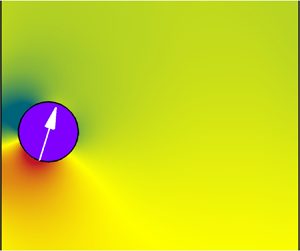Article contents
Two-dimensional study on the motion and interactions of squirmers under gravity in a vertical channel
Published online by Cambridge University Press: 11 April 2023
Abstract

We simulated the motions and interactions of circular squirmers under gravity in a two-dimensional channel at finite fluid inertia, aiming to provide a comprehensive analysis of the dynamic features of swimming microorganisms or engineered microswimmers. In addition to a squirmer-type factor (β), another control parameter (α) was introduced, representing ratio of the self-propelling strength to the sedimentation strength of squirmers. Simulations were performed at 0.4 ≤ α ≤ 1.2 and −5 ≤ β ≤ 5. We first considered the sedimentation of a single squirmer. Five patterns were revealed, depending on both α and β: steady downward falling, steady inclined falling or rising and small-scale or large-scale oscillating. Compared with a pusher (β < 0, gaining thrust from rear), a puller (β > 0, gaining thrust from front) is more likely to break down its symmetrical structure and subsequently lose stability, owing to the high-pressure regions on its lateral sides. Typically, a pusher settles faster than a puller, whereas a neutral squirmer (β = 0) settles in between. This is related to the ‘trailing negative flow’ behind a pusher and ‘leading negative flow’ before a puller. We then placed two squirmers in line with the gravity direction to study their interactions. Results show pullers attract each other and come into contact as a result of the low-pressure regions between them, whereas the opposite is observed for pushers. The interactions between two pullers are illustrated by their respective patterns. In contrast, pushers never come into contact and maintain distance from each other with increasing separation. We finally examined how a puller interacts with a pusher.
JFM classification
Information
- Type
- JFM Papers
- Information
- Copyright
- © The Author(s), 2023. Published by Cambridge University Press
References
- 22
- Cited by


